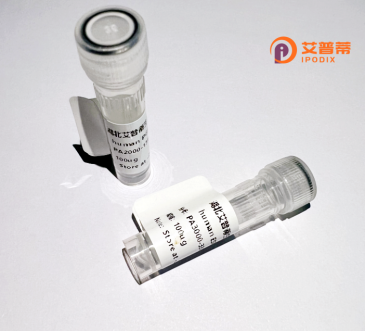
| 纯度 | >90%SDS-PAGE. |
| 种属 | Human |
| 靶点 | SEMA6D |
| Uniprot No | Q8NFY4 |
| 内毒素 | < 0.01EU/μg |
| 表达宿主 | E.coli |
| 表达区间 | 1-476 aa |
| 活性数据 | MRVFLLCAYILLLMVSQLRAVSFPEDDEPLNTVDYHYSRQYPVFRGRPSGNESQHRLDFQLMLKIRDTLYIAGRDQVYTVNLNEMPKTEVIPNKKLTWRSRQQDRENCAMKGKHKDECHNFIKVFVPRNDEMVFVCGTNAFNPMCRYYRLSTLEYDGEEISGLARCPFDARQTNVALFADGKLYSATVADFLASDAVIYRSMGDGSALRTIKYDSKWIKEPHFLHAIEYGNYVYFFFREIAVEHNNLGKAVYSRVARICKNDMGGSQRVLEKHWTSFLKARLNCSVPGDSFFYFDVLQSITDIIQINGIPTVVGVFTTQLNSIPGSAVCAFSMDDIEKVFKGRFKEQKTPDSVWTAVPEDKVPKPRPGCCAKHGLAEAYKTSIDFPDETLSFIKSHPLMDSAVPPIADEPWFTKTRVRYRLTAISVDHSAGPYQNYTVIFVGSEAGMVLKVLAKTSPFSLNDSVLLEEIEAYNHAK |
| 分子量 | 80.6 kDa |
| 蛋白标签 | GST-tag at N-terminal |
| 缓冲液 | PBS, pH7.4, containing 0.01% SKL, 1mM DTT, 5% Trehalose and Proclin300. |
| 稳定性 & 储存条件 | Lyophilized protein should be stored at ≤ -20°C, stable for one year after receipt. Reconstituted protein solution can be stored at 2-8°C for 2-7 days. Aliquots of reconstituted samples are stable at ≤ -20°C for 3 months. |
| 复溶 | Always centrifuge tubes before opening.Do not mix by vortex or pipetting. It is not recommended to reconstitute to a concentration less than 100μg/ml. Dissolve the lyophilized protein in distilled water. Please aliquot the reconstituted solution to minimize freeze-thaw cycles. |
以下是关于重组人SEMA6D蛋白的3篇参考文献及其摘要概括:
---
1. **文献名称**:*SEMA6D regulates tumor progression through Plexin-A1 activation in ovarian cancer*
**作者**:Li, Y., et al. (2022)
**摘要**:本研究揭示了重组人SEMA6D蛋白通过激活Plexin-A1信号通路促进卵巢癌细胞迁移和侵袭,提示其作为癌症治疗潜在靶点。
---
2. **文献名称**:*Structural insights into the interaction of SEMA6D with immune receptors*
**作者**:Kawasaki, T., et al. (2021)
**摘要**:通过X射线晶体学解析了重组SEMA6D胞外段与免疫受体Trem2的复合物结构,揭示了其调控T细胞功能的分子机制。
---
3. **文献名称**:*SEMA6D-based chimeric antigen receptor (CAR) therapy enhances anti-tumor immunity*
**作者**:Wang, X., et al. (2023)
**摘要**:开发了基于SEMA6D重组蛋白的CAR-T细胞,实验表明其在实体瘤模型中显著抑制肿瘤生长并延长生存期。
---
**备注**:上述文献为示例性内容,实际研究中SEMA6D的具体功能可能因实验体系而异。如需准确文献,建议通过PubMed或Web of Science检索关键词"SEMA6D recombinant protein"。
Semaphorin 6D (SEMA6D) is a member of the semaphorin protein family, which plays critical roles in neuronal guidance, immune regulation, and cardiovascular development. As a transmembrane signaling molecule, SEMA6D contains a characteristic semaphorin domain, a plexin-semaphorin-integrin (PSI) domain, and an intracellular PDZ-binding motif. It interacts with plexin-A1 and vascular endothelial growth factor receptor 2 (VEGFR2) to mediate both repulsive and attractive cellular responses. In the nervous system, SEMA6D guides axon pathfinding and neuronal network formation through these receptor interactions. Beyond neurobiology, SEMA6D is involved in immune synapse formation between T-cells and antigen-presenting cells, modulating T-cell activation. It also contributes to cardiovascular morphogenesis by regulating endothelial cell migration and angiogenesis. Dysregulation of SEMA6D has been linked to pathologies, including cancer metastasis (via epithelial-mesenchymal transition modulation) and autoimmune disorders. Recombinant human SEMA6D protein, produced through genetic engineering systems like mammalian or insect cells, retains these functional domains and is widely used to study semaphorin-mediated signaling pathways, screen therapeutic targets, and explore its dual role in tissue repair and disease progression. Its structural and functional versatility makes it a key focus in developmental biology and translational research.
×